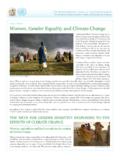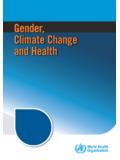Transcription of AN OVERVIEW OF VULNERABILITY ANALYSIS AND …
1 1 Box 1 What Is VAM? The VULNERABILITY ANALYSIS and Mapping (VAM) Unit is aninternal structure within WFP that provides temporary and long-term technical assistance in food security ANALYSIS to decision-makers at WFP Headquarters in Rome and in WFP Regional and Country Offices. The VAM network is currently comprised of three full-time international staff members in Rome Headquarters, 12 international VAM Officers, and approximately 20 VAM National Officers and VAM Focal Points. This network currently provides food security ANALYSIS coverage for 36 countries.
2 AN OVERVIEW OF VULNERABILITY ANALYSIS AND MAPPING (VAM) Contents: =What is VULNERABILITY ? =Ability to Cope =What does VAM do? =How to Undertake VAM =Assistance to Country Offices The Goals of VAM The broad goals of VAM are to: =Provide the factual basis for WFP country program design, in both the relief and development contexts, to identify, understand, and best address problems of food insecurity and VULNERABILITY in WFP partner countries. =Provide additional information and analytical support as needed during relief and development program implementation and evaluation phases.
3 The VAM strategy is a direct extension of the guidance provided in WFP s current Program Design Manual and Enabling Development strategy document . VAM is expressly an information tool for WFP relief and development program design, management, and evaluation. Working with WFP program staff in each country where it is operational, VAM will produce a range of analytical outputs intended to inform decision-making at key points within the WFP country programming cycle. As a result, the VAM analytical cycle is explicitly linked to the country programming cycle.
4 Specific VAM Objectives in Partner Countries At the country-level, VAM activities are designed to achieve the following results: =Develop focused and useful information products specifically linked to WFP program decision-making needs: =Define and target the most food insecure and vulnerable groups in an operationally useful fashion. 2 =Identify key risks and constraints to improved food security, and indigenous capacities to leverage in attempts to address those problems, as a means to frame the goals and objectives of a country program intervention strategy.
5 =Inventory and map local resource capabilities (infrastructure, personnel, and government/donor/NGO-supported services) available to complement WFP program operations. =Provide an information base for contingency planning and emergency needs assessment activities. =Monitor changes in the food security and VULNERABILITY status of target populations on a periodic basis over the course of the country program cycle and assess progress toward key WFP program objectives. =Develop other databases and information products necessary to inform decision-making during program implementation and evaluation.
6 =Transfer skills and develop sustainable capacity for information systems planning and ANALYSIS among local partners. =Support broader efforts at food security and VULNERABILITY policy and program development at the national level in VAM regions/countries. What is VULNERABILITY ? 1. The ANALYSIS and study of the VULNERABILITY of populations is a core responsibility and function of WFP. 2. VULNERABILITY is an important concept in food security. It is defined as the probability of an acute decline in food access or consumption levels below minimum survival needs.
7 It is a result of both exposure to risk factors - such as drought, conflict or extreme price fluctuations - and also of underlying socio-economic processes which reduce the capacity of people s ability to cope. Thus, VULNERABILITY can be viewed as follows: VULNERABILITY = exposure to risk + inability to cope 3. Fluctuations in food consumption levels usually result from: =variations in the home production of food commodities =variations in food prices =changes in the level of cash incomes from various sources. 4. Natural and man-made hazards, such as drought, floods, insect infestations, civil unrest and conflict can undermine household productive activities, limit access to non-farm sources of income, and disrupt the functioning of food markets.
8 5. VULNERABILITY tends to be greater when: =the risk of natural or man-made disasters is high; =long-term resource management practices and adverse government policies suppress productivity and consumption to chronically low levels; 3 =poor households typically rely on a single, risky source of consumption or income, or on a range of sources for which are all equally risky. 6. The groups usually considered to be the most food insecure and vulnerable include: =young children (especially those under 5 years of age) =pregnant/lactating women who are living in poverty, with poor access to and utilisation of food =female-headed households =the elderly =the disabled =disadvantaged groups with low levels of household labour, limited asset ownership, and insufficient means of support from family members and the community =households under the threat of conflict, drought and other risks, particularly poor families which lack a diversified income and asset base.
9 7. VULNERABILITY is usually assessed as a probability. The country food needs assessment process concentrates on understanding: =the geographic scope and intensity of a given situation =the ability of different population groups to cope with the effects of such a situation and maintain an adequate level of consumption. 8. In this context, needs assessments must identify the most appropriate assistance to enable affected households to better cope with the implications of structural problems or emergency conditions and eventually, to re-gain some degree of economic viability and self-sufficiency.
10 Ability to Cope 1. Households are often able to cope to some extent with the effects of a crisis. Typical coping mechanisms include: =draw-downs on household stocks and assets =transfers from family members working in other areas or abroad =reduced food consumption =increased use of wild foods or consumption of less preferred foods =assistance from local community or religious support networks =government safety net programs. 2. Coping mechanisms effectively seek to augment the resources (or income ) available to the household.















